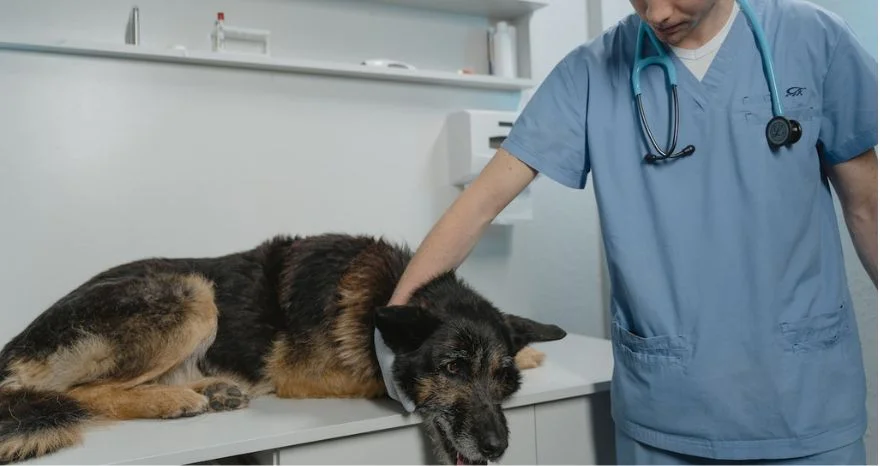However, it is time for euthanizing when the dog’s pain may cease to bother, or the animal may stop eating. The owner, who is so attentive to his pet’s behavior, may simply understand that his life’s quality has become miserable.
The perfect time to put down a canine with Osteosarcoma can be the painful situation of your dog, difficulty dieting, also generally has a feeble life. Talk to your veterinarian first to discern if it’s time to leave the dog.
That’s because it can be sad to see how our furry friend endures the pain of this condition. Nothing can prepare us enough to hear such a diagnosis and decide to stop.
What Is Osteosarcoma In Dogs?
To respond to the query “what is the right time to euthanize a dog with osteosarcoma” you should initially realize osteosarcoma.
Osteosarcoma is an aggressive bone disease that mainly affects large and giant breed dogs. Usually, it happens when a mass of dysfunctional bone cells (tumor) begins to grow deep within the dog’s bones. Moreover, this can starts to invade and destroy healthy bone cells.
The disease usually develops in the limbs, although it can grow on any bone. According to Veterinary Partner, appendicular osteosarcoma, or a tumor in the bone of one leg, accounts for 75% to 85% of all bone tumors in dogs.
As cancer progresses, the dog will experience severe pain because cancer destroys its bone from the inside out. Cancer cells can also spread to other parts of the body, such as the lungs.
Severe and elderly dogs are more prone to the disease. Those weighing over 90 lbs make up almost a third of all cases, and a dog that has just turned 8 is at greater risk of developing the disease.
Some breeds are also more sensitive, such as the German Shepherd, Rottweiler, Irish Setters, Golden Retriever, and St. Bernards. Moreover, Doberman pinscher, Irish Wolfhounds, Greyhounds, Scottish Foxhounds, Great Dane, and Leonberger also has some sensitivity issue with Osteosarcoma.
Notably, the Canine Health Foundation notes that osteosarcoma is the most ordinary form of bone cancer in canines in the United States. About 10,000 dogs in the United States develop this advanced bone cancer each year.
Symptoms of Osteosarcoma
A bone malignancy called osteosarcoma is the most widely recognized sort of essential bone disease in canines and records for more than 95% of every bone tumor. Although osteosarcoma is a severe condition, the signs of bone cancer are so subtle that you may not immediately recognize them.
This is especially in the early stages of the disease. Bone cancer usually occurs on a dog’s front legs. However, it may affect the facial bones, jaw, vertebrae, hind legs, and ribs.
Bone cancer symptoms can include:
It starts with dog osteosarcoma heavy breathing or lameness with swelling in the ribs. Not disappearing dissatisfaction and lumping of the influenced bone are the most widely recognized side effects when the tumor affects one limb.
Your dog may face difficulty eating when the jaw is swollen. However, this is frequently the primary indication of growth in the jaw, skull, or ribs. Also, your dog may face a vertebral / Spinal Tumor.
Moreover, neurological symptoms likewise seizures or unsteady pace involving the bone or loss of lethargy and appetite may occur.
Some Osteosarcoma Inclined Canine Breeds
Osteosarcoma usually affects the leg bones of large and giant breed dogs. Again, large and tall dogs generally develop tumors at a young age. Puppies under six months of age may develop osteosarcoma.
The following dog breeds are most susceptible to osteosarcoma
Borjas, Bernese Mountain dogs, Doberman pinscher, Boxers, Golden retriever, German shepherds, Hounds, Great Dane, Irish wolfhounds, Irish regulators, Leonbergers, Labrador rebound, St. Bernard, Rottweilers, Weimaraners, and Scottish greyhounds.
In addition, larger, heavier dogs are more likely to develop osteosarcoma. For example, dogs weighing over 90 lbs account for about a third of all cases of osteosarcoma.
Causes of Osteosarcoma
What Causes Osteosarcoma Cancer? The reason is unknown. A variety of risk factors can be a reason, including environmental, hereditary, or genetic. Recent studies have shown that 70% of cases of osteosarcoma are genetically transmitted from dogs.
Notably, this life-threatening cancer is very aggressive and affects mainly large breed dogs. However, knowledge of the disease does not link it to their size or gender. Rottweilers and Irish wolfhounds are especially susceptible to the disease.
Uncontrolled cell growth and cell invasion of structures that deposit bone minerals account for nearly 80% of all bone cancers. And this cancer is very competitive and life-threatening.
What is the right time to euthanize a dog with osteosarcoma?

There is no one-size-fits-all answer to the question of euthanizing a dog with osteosarcoma, as there are many factors to consider.
However, for many dog owners, it all depends on the quality of life. Since we cannot ask our dogs how they are doing every day, it is essential to understand the signs of a dog’s illness. Let’s explore some signs that may answer your query “what is the right time to euthanize a dog with osteosarcoma”:
Lose weight quickly:
Initially, your dog loses weight gradually. It can be the symptoms of osteosarcoma.
Loss of appetite:
A sharp decrease in appetite may occur in your dog. And it may lose interest in taking foods.
Constant diarrhea or vomiting:
You may notice your dog having diarrhea and vomit frequently. It will be seriously painful for your dog.
Breathing changes:
Your dog’s breathing frequency will change. And it will again remember you to reduce the pain.
Lameness or weakness that persists:
For refusing the food, day by day, your dog will become weak. And this moment will concern you about its health hazards.
Difficulty moving every day:
As your dog becomes weak, it cannot move easily. And this disability will be painful for both your dog and you. So, it’s better to euthanize your dog.
However, day by day, you will watch lethargy or indifference to things he once loved and some drastic change in their daily habits. So, it’s over. Put him down as soon as you can.
You know your dog friend well, so it’s up to you to help him when his daily behavior and interests begin to change. Indeed, the end of a dog life with bone cancer is very pathetic! It is essential to know that you are not alone, as veterinarians can help you with this decision-making process.
Can bone cancer in dogs be misdiagnosed?
Yes, it can be. Many veterinarians do a physical exam to look for swelling or pain at the site of the node. If the cancer is in the leg, your veterinarian can damage your dog’s bones or limbs.
Osteosarcoma in dogs can sometimes occur in the skull or spine. If this happens, it could be a runny nose, salivation, puffy eyes, neurological problems, and difficulty drinking or eating.
Veterinarians can also use X-rays to look for signs of metastases. Your veterinarian will take x-rays of your chest and bones throughout your body. Usually, we found bone metastases earlier than lung metastases.
Some veterinarians may also perform a surgical biopsy as this is the only way to diagnose a bone lesion as cancer definitively.
Laboratory tests can also be a possible way. The blood profile helps determine the general health of the dog and the treatment options it can tolerate. An abdominal ultrasound may also be helpful as a part of a metastatic screening test.
If you are considering surgery for a limb or a bone tumor in your dog’s leg, your veterinarian may perform an extended computed tomography. He may also take some other advanced imaging techniques.
Despite physical examinations and X-rays that indicate cancer, sometimes the diagnostic tests fail to detect it. Again, we may require a bone biopsy to make a definitive diagnosis.
How fast does bone cancer spread in dogs?

How fast does osteosarcoma spread? Osteosarcoma in dogs spreads rapidly through the bloodstream. Therefore, any osteosarcoma in dogs’ treatment plan must address the secondary spread of cancer and the primary tumor itself. The long-term survival rate is about 75%. If the osteosarcoma has spread to the lungs or other bones at the time of diagnosis, the rate drops to 30%.
Life expectancy can be:
With proper treatment – increase a canine’s life expectancy to around a half-year.
Without therapy – the average endurance time is around two months
Chemotherapy and Palliative radiation – gives a future of around a half-year
Limb-sparing surgery – offers a similar endurance time as removal and chemotherapy
Chemotherapy and Treatment – about a year for certain canines getting a charge out of a decent personal satisfaction for a very long time
How to prevent bone cancer in dogs?
Unfortunately, osteosarcoma is an incurable disease, and most treatment options aim to prolong the dog bone cancer life expectancy. In any case, there is at present no realized method to prevent bone sarcoma. Early detection and treatment allow the best opportunity for a sound life.
In this case, treatment has two options:
First, to relieve the severe pain the dog is experiencing and reduces the disease’s metastatic component (rapid spread).
The first available option for pain relief is amputation of the limb on the tumor locating area. In most cases, this relieves pain immediately. However, the risk of spreading the disease remains very high.
Another option for pain relief is sedative radiation therapy and pain relievers known as bisphosphonate infusion therapy.
Your vet doctor can operate on the extremities, in which he will remove the tumor, amputating the foot. However, the doctor must do it in combination with chemotherapy.
Notably, this type of surgery also requires special postoperative care as the limb takes a long time to heal. Additional treatment options a dog may receive include pain relievers.
They usually do not help a dog with severe pain it is experiencing and only consider it if amputation and palliative radiation therapy are not appropriate. Treatment options are also available, such as targeted diet therapy, which uses a ketogenic diet to treat cancer in dogs.
Other alternative treatments include a holistic, natural approach that prevents dog bone cancer progression.
These include many treatments such as injections of a blend of vitamins A and D, bromelain, omega-3 fatty acids, and an herbal blend called the Hoxsey formula with bones. There are cases where these treatments have been very successful in treating cancer.
FAQ:
How Long Can dogs live with Osteosarcoma without treatment?
Without treatment, the median survival period is about two months. The pain linked with the primary tumor determines this. If you do an amputation, the median survival period increases to 6.5 months, with about 2% of dogs living after 2 years. The average life expectancy of patients undergoing palliative radiation therapy and chemotherapy is six months. The response to chemotherapy results in a mediocre survival time of less than a year, and 20% of canines enjoy a wonderful life 2 years after the surgery.
How quickly does Osteosarcoma progress in dogs?
Osteosarcoma of the extremities is popular as appendicular osteosarcoma. And it grows deep inside the bones and gradually becomes a tenderer as it extends outward and destroys the bone from the inside. However, lameness ranges from intermittent to persistent over one to three months.
How much does it cost to treat osteosarcoma in dogs?
The operation cost itself depends on the vet’s specialization and quality. Also, it depends on the tumor’s anatomical position but usually ranges from $ 1,000 to $ 3,000. Chemotherapy usually adds another 2,000 USD to 4,000 USD (based on the etiquette chosen and the size of the dog).
Should I amputate my dog’s leg with osteosarcoma?
While it may seem drastic, removing the tumor is the most efficient way to reduce bone cancer discomfort and avert fractures. Therefore, amputation can be the procedure that further enriches your dog’s life quality. The usual recovery period after surgery is around 10 to 14 days. But, most dogs walk much faster on their three legs. You can bring adequate pain relief throughout and after the pet’s surgery with local anesthesia and oral analgesics.
Final Verdict
There isn’t anything more terrible than bidding farewell to our hairy family members and understanding how important it is to spend time with them.
Watch for signs and symptoms to find out what is the right time to euthanize a dog with osteosarcoma. Early perception is the key to success. It is always best to know what treatment options are available for dogs with osteosarcoma and gets a treatment that will help relieve pain and give your dog more time.
Indeed, you are in good company in this—request help. Professional veterinarians will help and give additional advice.
I wish you and your dogs peace and comfort!


Pingback: Dog Suddenly Scared of Something in House? | PetDaliyPress
Pingback: When to Euthanize a Dog with Cushing’s Disease | PetDaliyPress